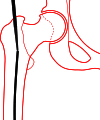A Novel Technique for the Removal of an Intramedullary Femoral Guidewire Lodged in the Femoral Canal
- PMID: 33655108
- PMCID: PMC7746120
- DOI: 10.51894/001c.5785
A Novel Technique for the Removal of an Intramedullary Femoral Guidewire Lodged in the Femoral Canal
Abstract
Intramedullary nails are currently the most commonly used device for the fixation of intertrochanteric hip fractures. An initial threaded guidewire is used for localizing the site of entry and determining the final position of the fixation device. Hardware failure with guidewire breakage can complicate the procedure and lead to unplanned challenges for the surgeon. Predisposing mechanical properties of the hardware, along with technical surgical errors may lead to inadvertent breakage or migration of guidewires. The authors report a case of initial threaded starting guidewire migration into the femoral intramedullary canal with subsequent impaction into the distal femoral subchondral bone after advancement of the proximal femoral canal reamer. A method for antegrade removal of a lodged intramedullary guidewire through the distal femoral condyles is described. A set of key technical points to avoid this complication are also provided. Although guidewire migration during hip fracture surgery is a rare occurrence, it is important to recognize the technical measures that can be used to prevent this potentially devastating complication. Surgeons should be familiar with several different techniques for extraction of such hardware surrounding the hip, as there is no universally successful method.
Keywords: fracture fixation; guide wires; intramedullary fractures.
Figures



Similar articles
-
A technique for extraction of the distal segment of a broken femoral nail using a flexible reamer.Injury. 2017 Aug;48(8):1858-1860. doi: 10.1016/j.injury.2017.06.010. Epub 2017 Jun 16. Injury. 2017. PMID: 28645423
-
Sliding Hip Screw and Side Plate for Intertrochanteric Hip Fractures.JBJS Essent Surg Tech. 2022 Feb 16;12(1):e19.00038. doi: 10.2106/JBJS.ST.19.00038. eCollection 2022 Jan-Mar. JBJS Essent Surg Tech. 2022. PMID: 35685237 Free PMC article.
-
Breakage of intramedullary femoral nailing or femoral plating: how to prevent implant failure.Eur J Med Res. 2022 Jan 13;27(1):7. doi: 10.1186/s40001-021-00630-7. Eur J Med Res. 2022. PMID: 35027077 Free PMC article.
-
A rare complication of pelvic perforation by an excessive medial slide of the helical blade after treatment of an intertrochanteric fracture with proximal femoral nail anti-rotation: A case report and literature review.Chin J Traumatol. 2022 Mar;25(2):118-121. doi: 10.1016/j.cjtee.2021.08.007. Epub 2021 Aug 12. Chin J Traumatol. 2022. PMID: 34509352 Free PMC article. Review.
-
A novel surgical technique for removal of intramedullary nails when there is a failure of the proximal extraction device: Report of two cases and review of literature.Injury. 2024 Jun;55(6):111533. doi: 10.1016/j.injury.2024.111533. Epub 2024 Apr 4. Injury. 2024. PMID: 38631082 Review.
Cited by
-
Retrieval of broken intra-medullary guide wire in femoral shaft fracture: A case report and surgical technique.Trauma Case Rep. 2023 Jun 4;46:100865. doi: 10.1016/j.tcr.2023.100865. eCollection 2023 Aug. Trauma Case Rep. 2023. PMID: 37347005 Free PMC article.
References
-
- American Board of Orthopaedic Surgery Research Committee. Nail or plate fixation of intertrochanteric hip fractures: changing pattern of practice. A review of the American Board of Orthopaedic Surgery Database. Anglen J.O., Weinstein J.N. 2008J Bone Joint Surg Am. 90:700–7. - PubMed
-
- Short Versus Long Intramedullary Nails for Treatment of Intertrochanteric Femur Fractures (OTA 31-A1 and A2. Boone C., Carlberg K.N., Koueiter D.M., Baker K.C., Sadowski J., Wiater P.J., al et. 2014J Orthop Trauma. 28:e96–100. - PubMed
-
- A technique to remove a broken guide wire transfixing the hip joint. Sharma H., Chauhan M., Maini L. 2008Acta Orthop Belg. 74:683–5. - PubMed
-
- Broken Kirschner or guide-wire retrieval: A report of 4 cases. Sen R.K., Tripathy S.K., Aggarwal S., Agarwal A., Goyal T., Tahasildar N., al 2010Hip Int J Clin Exp Res Hip Pathol Ther. 20:551–4. - PubMed
-
- Intrapelvic protrusion of guide wire during fixation of fracture neck of femur. Mishra P., Jain P., Aggarwal A., Upadhyay A., Maini L., Gautam V.K. 2002Injury. 33:839–41. - PubMed
Publication types
LinkOut - more resources
Full Text Sources
